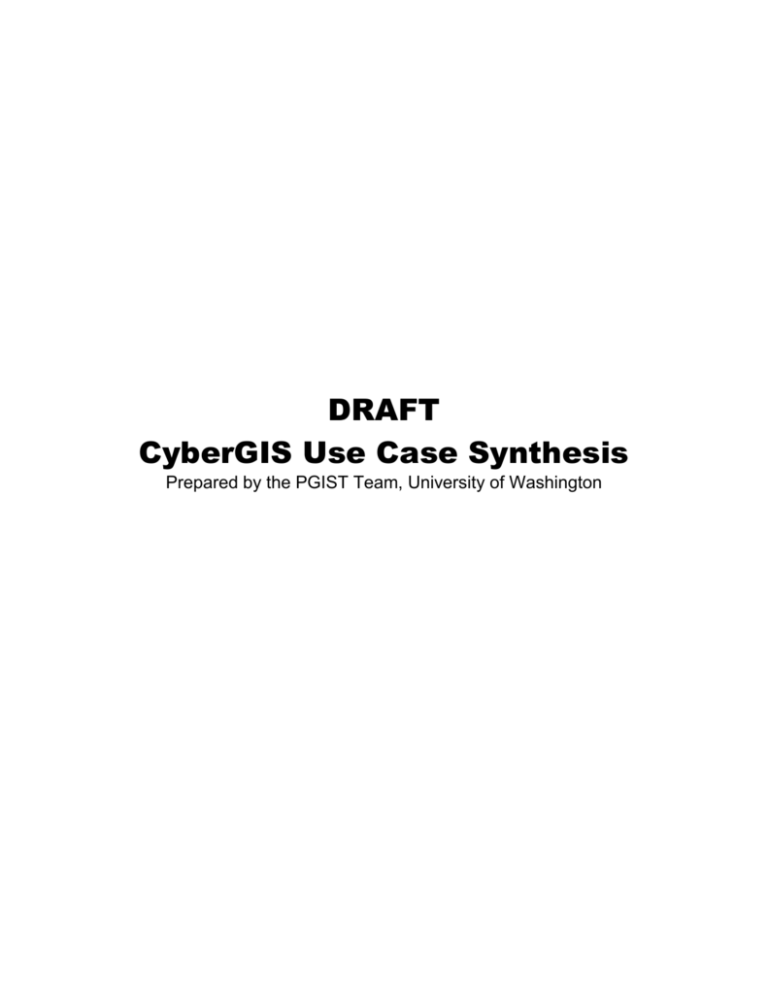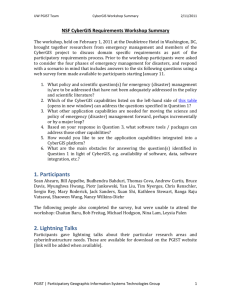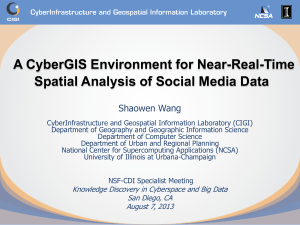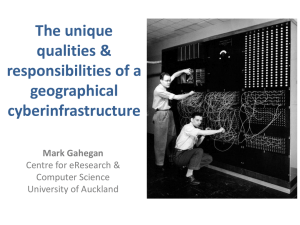Executive Summary - University of Washington
advertisement

DRAFT CyberGIS Use Case Synthesis Prepared by the PGIST Team, University of Washington Table of Contents EXECUTIVE SUMMARY 2 1. INTRODUCTION 3 2. USE CASE OVERVIEW 3 3. EMERGENCY MANAGEMENT BUSINESS USE CASES 7 3.1. 3.2. 3.3. 3.4. 4. EM.BUC.1 WILDFIRE EVACUATION TRIGGERS EM.BUC.2 DYCAST SYSTEM FOR WEST NILE EM.BUC.3 MONITORING SOCIAL VULNERABILITY TO NATURAL HAZARDS EM.BUC.4 POST-EVENT TOPOGRAPHIC (AND URBAN) CHANGE DETECTION SOFTWARE ELEMENT BUSINESS USE CASES 7 8 10 12 13 4.1. SE.BUC.1 OPTIMIZING SENSOR LOCATION NETWORK 4.2. SE.BUC.2 INTERACTIVE VISUAL ANALYTICS ON SPATIAL/TEMPORAL VARIABILITY AND DIFFERENTIATION OF GLOBAL SURFACE TEMPERATURES 4.3. SE.BUC.3 COLLABORATIVE BRAINSTORMING 13 5. 18 5.1. 5.2. 5.3. 5.4. 5.5. 5.6. SOFTWARE ELEMENT SYSTEM USE CASES SE.SUC.1 AGENT-BASED MODELING SE.SUC.2 PGID (PARALLEL HOT SPOT ANALYSIS) SE.SUC.3 PIDW (PARALLEL SPATIAL INTERPOLATION) SE.SUC.4 CYBERGIS GATEWAY COMPUTATION MANAGEMENT SERVICE SE.SUC.5 RASTER REPROJECTION SE.SUC.6 USER-PROVIDED FEEDBACK ON CYBERGIS GATEWAY 15 16 18 20 21 23 25 25 1 DRAFT CyberGIS Use Case Synthesis v.2011.10.13 Executive Summary CyberGIS provides a collaborative platform for integrating a variety of geospatial software elements to solve complex, computationally intensive problems. The use cases described in this document capture high-level problem solving needs as well as current software element capabilities. The thirteen uses cases were contributed by CyberGIS project members and disaster and emergency science and management (DESM) researchers following a web survey and requirements workshop, and are intended to provide an operational requirements perspective. They have been grouped into two categories: business - the high-level problem to be solved, and system - the capabilities needed to do the analyses and support collaborative decision-making. The four emergency management business use cases describe wildfire, vector-borne disease, social vulnerability, and topographic/structural change scenarios. Three further use cases are included in the ‘business’ category because they describe more general aspects of geospatial-problem solving that are relevant for emergency management as well as other types geospatial research: optimizing sensor networks, visualizing spatial/temporal variability of global surface temperatures, and collaborative brainstorming. The final six system use cases describe specific CyberGIS software element capabilities: agent-based modeling, parallel hot spot analysis, parallel spatial interpolation, computation management, raster reprojection, and structured feedback. The range of use cases represents the diversity of research that CyberGIS can support and the need for on-going contributions to the platform. Ideally, the business use cases should be supported by one or more system use cases. Due to the distributed and voluntary nature of the participatory requirements process and software element contributions, this one-to-one or one-to-many relationship is not given at this time. However, the identification of missing functionality is important to drive future requirements and prioritize software element integration. The gaps between the emergency management and software element use cases also indicate the need for both a top-down, domain science driven and a bottom-up, interoperability-focused integration strategy. 2 DRAFT CyberGIS Use Case Synthesis v.2011.10.13 1. Introduction Through the CyberGIS participatory requirements process a range of requirements is being identified and elaborated simultaneously: Business requirements – the character of geospatial problem solving. System requirements – capabilities to address geospatial problem solving. Component requirements – software design for implementing capabilities. Application requirements – packaging the components into solutions to address scientific problem solving requirements. To start the process, a web survey was distributed to both emergency management researchers and CyberGIS project members who identified geospatial problem solving needs with respect to four main areas: analysis, data, interaction and integration. Participants also provided input on system architecture and high performance computing requirements.1 Use cases are the next level of specification in the participatory requirements process. They provide a more detailed description of geospatial problem solving needs and system capabilities as well as indicating component and application requirements. Specific integration issues and needs are also evolved through use cases. 2. Use Case Overview The use cases fall into two general categories: business and system. The business use case is meant to answer “what do you want to do” with a focus on the human dimension – how users interact with each other and the system to perform work. The system use case addresses the question of “how will it get done” with a focus on the system and the interactions within the system while performing some work. Figure 1.1 illustrates these relationships. Figure 1.1 Relationship between business and system use cases. 1 See PGIST web site, Software Requirements: Participatory Process page, section 1.2: http://depts.washington.edu/pgist/cybergis/softreq. 3 DRAFT CyberGIS Use Case Synthesis v.2011.10.13 Both emergency management researchers and CyberGIS project members contributed use cases that are categorized as emergency management (EM) business, software element (SE) business and SE system: EM business use cases address a topic or problem specifically related to emergency management. SE business use cases describe a more general aspect of geospatial problem solving that could be used in emergency management research, but could also be integrated into other types of research such as climate change. They are SE business use cases because they can be mapped to one or more software elements, but differ from a system use case because they describe ‘what’ the software element does. SE system use cases describe how the software element works in more technical terms including interactions with the CyberGIS Gateway and generic computational infrastructure. Table 1.1 provides an overview of the contributed use cases. The use cases are described in more detail in the sections that follow. Table 1.1 Overview of contributed use cases Type* / ID Contributor Topic EM Business Tom Cova Wildfire Evacuation Triggers EM.BUC.1 EM Business Sean Ahearn DYCAST System for West EM.BUC.2 Nile Analysis EM Business Serge Rey Monitoring Social Vulnerability EM.BUC.3 to Natural Hazards EM Business Chris Crosby Post-event Topographic (and EM.BUC.4 Urban) Change Detection SE Business Piotr Optimizing Sensor Location SE.BUC.1 Jankowski Network SE Business Xuan Shi Interactive Visual Analytics on SE.BUC.2 Spatial/Temporal Variability and Differentiation of Global Surface Temperatures SE Business Mary Roderick Collaborative Brainstorming SE.BUC.3 SE System Yan Liu Agent-based Modeling SE.SUC.1 SE System Yan Liu pGID (Parallel Hot Spot SE.SUC.2 Analysis) SE System Yan Liu pIDW (Parallel Spatial SE.SUC.3 Interpolation) SE System Yan Liu CyberGIS Gateway SE.SUC.4 Computation Management Service EM Phase Response Preparedness Preparedness Recovery Preparedness Preparedness, Mitigation All 4 DRAFT CyberGIS Use Case Synthesis v.2011.10.13 SE System SE.SUC.5 SE System SE.SUC.6 David Mattli Raster Reprojection Michalis Avraam User-provided Feedback on CyberGIS Gateway using Brainstorm Concerns Tool *EM – Emergency Management, SE – Software Element The use cases are included in full, as they were contributed. For each business use case, a requirements synthesis table summarizes the capabilities needed and matches these to software elements and system use cases. Table 1.2 describes the current capabilities and software elements included in CyberGIS. 5 DRAFT CyberGIS Use Case Synthesis v.2011.10.13 Table 1.2 Overview of CyberGIS capabilities and software tools that include complementary software elements GISolve* pGID/pIDW Agent-Based Modeling (ABM) GIS/SAM GeoDa/PySAL* OpenPGIST* Topography* ? ? BCT/CCT/CST PdGRASS* ? ⃟ Choice Modeling ⃞ Domain-Specific Modeling ⃞⃟ Geostatistical Modeling ⃞⃟ Local Clustering Detection ⃞⃟ ⃞⃟ Spatial Interpolation ⃞⃟ ⃞⃟ Spatial Econometrics ⃞⃟ ⃞⃟ Visualization & Map Operations ⃟ Spatial Middleware ⃞⃟ Generic CI Capabilities ⃞⃟ Online Problem-Solving ⃞⃟ ⃞⃟ User Interface ⃞API & Library ⃟ Service ⃞⃟ ⃟ ⃞ ⃞ ⃞⃟ ⃞ Open Source Capabilities and interfaces of existing GIS/SAM software toolkits (GISolve: high-performance and collaborative GIS toolkit; GeoDa and PySAL: spatial analysis toolkit; OpenTopography: analysis toolkit for topographic data; PGIST: Participatory GIS; pd-GRASS). *Individual capabilities for use in emergency management are specified under the name of the element. 6 DRAFT CyberGIS Use Case Synthesis v.2011.10.13 3. Emergency Management Business Use Cases 3.1. EM.BUC.1 Wildfire Evacuation Triggers Overview Title: Setting Wildfire Evacuation Trigger Points Description: A wildfire has ignited in proximity to a dense canyon community. The fire does not currently threaten the community, but incident commanders (ICs) have concern about whether the community may need to be evacuated should the wind speed increase over the next 24 hours, as expected. Based on a forwardlooking scenario for the next 24 hours, they would like to set nested trigger points on the landscape that would initiate protective actions as the fire approaches the community. The first trigger point reached by the fire would result in an evacuation stand-by order, and the second trigger would result in an evacuation order. ICs will be using the Ready-Set-Go strategy where “ready” means there’s a fire in your area, “set” means to prepare to evacuate (i.e. stand-by) and “Go” means to evacuate. Contributor: Tom Cova and Phil Dennison, University of Utah Initial Status Actors: Decision makers (not co-located), fire scouts at the on-site incident command center, community residents, CyberGIS decision support analyst. Interfaces: Each of the decision makers has access to a shared map-based representation of the fire and area at risk. They need to collaborate to determine about how much time they think the community will need to prepare and subsequently evacuate in addition to how much time they might have available before the fire impacts the community given the short-term weather predictions. Preconditions: Real world - Fire near an at-risk community, decision makers that are not together, scouts on the ground. CyberGIS - A fire-spread model and an evacuation trigger generator with grid computing power and a geo-collaborative interface for remote decision support. Basic Flow 1. The decision makers review the situation through the map-based interface and provide a stand-by time (e.g. 3 hours or warning) for the community and a minimum time (e.g. 2 hours of warning) for evacuating the community. 7 DRAFT CyberGIS Use Case Synthesis v.2011.10.13 2. The CyberGIS analyst takes the current reported fire location, predicted weather for the next day, and expert estimates of evacuation times and computes a dynamic (short term) estimate of the trigger points for both standby and evacuation warnings. 3. The decision makers review the resulting trigger points and decide whether they are appropriate given the conditions of the community and fire. 4. The decision makers decide to set (or not set) the trigger points as computed, but if they are set then scouts on the ground will report when the triggers have been activated to the incident command center. Post Conditions The decision makers selected the trigger points and they were tripped or not tripped. The decision makers did not set trigger points based on the CyberGIS analysis. Alternative Flows The decision makers ask for different weather predictions to be input into the system to test the sensitivity of the trigger points to changes in weather inputs as well as changes in the evacuation time estimates. The results of the sensitivity analysis might be to: 1) not use the CyberGIS approach because of its heightened sensitivity in this scenario, or 2) to decide that the computed trigger points are sufficiently sound. Requirements Synthesis Capabilities Needed Domain-specific Modeling Agent-based Modeling Visualization & Map Ops Generic CI Capabilities Online Problem Solving Other 3.2. Applicable Software Element Use Case GISolve, GeoDa/PySAL CI-based ABM SE.SUC.1 pd-GRASS CyberGIS Comp Mgmt Service SE.SUC.4 GISolve There is a possible synergy with SE.BUC.1 Optimizing Sensor Location Network, where the sensors could be used as the wildfire triggers. EM.BUC.2 DYCAST System for West Nile Overview Title: Dynamic Continuous Area Space-Time (DYCAST) System for West Nile Virus Prospective Description: The West Nile virus (WNV) is a mosquito-borne disease-causing infectious agent 8 DRAFT CyberGIS Use Case Synthesis v.2011.10.13 that affects wildlife and domestic animals. Birds act as an amplifying host and their death from the virus presages the spread of the virus to human populations. Most states set up call in numbers for public reporting dead birds. Bird locations and species are input to a database. There data are sent to the DYCAST Model for processing. Results are displayed on an internet site and can be downloaded into a local GIS. Contributor: Sean C. Ahearn, Hunter College CUNY Initial Status Actors: Public: for crowd sourcing location of dead birds (i.e. 1-800-DEAD-BIRDS) State Health Officials: for compilation and geo-coding of data and transfer to DYCAST model. Mosquito control boards: that use model for monitoring and remediation. Interfaces: Calibration tool --> Kappa Analysis --> DYCAST model run --> reporting tool Preconditions: WNV activity in the previous year that could be used for calibrating the model. Basic Flow Calibrate model from previous years dead-bird data. Parameters will include: (1) size of spatial- temporal domain & (2) size of spatial-temporal close-in-spaceclose-in-time sub-domain. Run Monte-Carlo simulation to obtain an empirical distribution for the combination of the spatial-temporal domain and its close-inspace-close-in-time sub-domain. Use a spatial-temporal Kappa analysis to find the lag and window size that represents the period of maximum predictability of human (risk of) infection. Run the model prospectively starting at the beginning of the season. Report DYCAST areas of risk (based on a grid size of 1/4 mile) to mosquito control boards for monitoring and remediation using a web-based portal. Post Conditions The model runs every day of the WNV season (May to October). Results from each day can be used in a post-season analysis for validation. For seasons 2005-2008 model was run every day for every 1/4 x 1/4 mile of the State of California. Alternative Flows Other data can enter into the model such as real-time meteorological data, demographic layers, soils, land-use layers and hydrology layers. 9 DRAFT CyberGIS Use Case Synthesis v.2011.10.13 Requirements Synthesis Capabilities Needed Generic CI Capabilities Visualization & Map Ops Other 3.3. Applicable Software Element Use Case CyberGIS Comp Mgmt Service SE.SUC.4 Requires a static map presented on a web page, which GISolve can provide. DYCAST appears to encapsulate other capabilities like domain-modeling and visualization/map ops. However, pGID SE.SUC.2 could assist the identification of spatio-temporal domains and close-in-space-close-in-time domains (needed for model calibration) from location-based observations on dead birds. EM.BUC.3 Monitoring Social Vulnerability to Natural Hazards Overview Title: Monitoring Social Vulnerability to Natural Hazards Description: For long-term emergency management, it is important to monitor the spatial distributions of vulnerable populations exposed to natural hazards and establish place-based plans for responding to and recovering from disaster events. A group of regional planners would like to estimate social vulnerability by areas in the U.S.and examine how spatial distributions have changed over time. They particularly want to identify which places have experienced a continuous increase or decrease in their vulnerability. Contributor: Serge Rey, Arizona State University Initial Status Actors: Planners, decision-makers, analysts Interfaces: Planners access a web-mapping interface of the CyberGIS Gateway where they can estimate and visualize social vulnerability and its temporal changes. Analysts may want to access back-end vulnerability analysis tools through web services in order to feed the analysis results into other analysis tools. Decision-makers may not directly visit the CyberGIS Gateway. They instead use external web applications that show only vulnerability maps generated by the CyberGIS Gateway. 10 DRAFT CyberGIS Use Case Synthesis v.2011.10.13 Preconditions: Database necessary for estimating social vulnerability indices (e.g., historical census data) Computational tools to estimate the indices and their spatial autocorrelation (e.g., global and local indicators of spatial autocorrelation) Computational tools to estimate the trend of temporal changes of the indices at each spatial observation Online mapping services and applications to generate and render vulnerability maps Basic Flow 1. The planners access the web-mapping interface and request vulnerability estimation for a specific time period. 2. The interface shows choropleth or density maps of the estimated vulnerability index for each time point. 3. The planners use map animation or other advanced interaction tools to examine the spatial patterns of the estimated index. They might see some clustering patterns during the map interactions. In such case, they test whether or not the observed spatial clustering is statistically significant. 4. The planners now estimate the trends in the temporal changes of the index for each observation. 5. The interface generates a map of observations at each of which the index has significantly increased. 6. During the above analysis, the planners select a few important maps and feed them into a web application that relevant decision-makers often use. 7. Some analysts may have other source data for the vulnerability estimation but cannot share it through the CyberGIS Gateway. In such case, they use the additional web services interface to estimate the vulnerability index for their own data. Post Conditions The planners obtained vulnerability maps and identified the areas with increasing or decreasing vulnerability. The planners obtained vulnerability maps but could not identify any areas that have experienced consistent changes in their vulnerability. The planners failed to obtain vulnerability maps. Alternative Flows N/A Requirements Synthesis Capabilities needed Geostatistical Modeling Local Clustering Detection Applicable Software Element GISolve pGID Use Case SE.SUC.2 11 DRAFT CyberGIS Use Case Synthesis v.2011.10.13 Visualization & Map Ops Generic CI Capabilities Online Problem Solving as brainstorming and synthesizing concerns GISolve CyberGIS Comp Mgmt Service GISolve, PGIST SE.SUC.4 SE.BUC.3 Other 3.4. EM.BUC.4 Detection Post-event Topographic (and Urban) Change Overview Title: Post-event topographic (and urban) change detection for EM response and rebuilding Description: The Haiti EQ demonstrated that high-resolution topography collected following a natural disaster can be invaluable for evaluating extent of damage to building stock, determining locations for relocation camps, and tracking displaced people. Contributor: Chris Crosby, San Diego Supercomputer Center Initial Status Actors: Emergency responders, relief workers, NGOs Interfaces: Web-based portal to data, Web services for data access, processing and analysis. Preconditions: Existing data distribution, processing, analysis and visualization infrastructure. Post- (and hopefully pre-) event data. Basic Flow 1. High-resolution LiDAR data are collected immediately following the event, and are processed and delivered as quickly as possible 2. Pre-event data, if available are located and loaded into data system along side post-event data 3. Responders and recovery workers access data via web-based portal, perform basic change detection, hydrologic, and other analysis on hosted data. 4. Results of analysis are delivered as simple geolocated visualization products 12 DRAFT CyberGIS Use Case Synthesis v.2011.10.13 (preferably useable on a mobile platform for use in the field). Post Conditions Data are online and publicly available for future use. Alternative Flows N/A Requirements Synthesis Capabilities Needed Geostatistical Modeling Local Clustering Detection Visualization & Map Ops Other Applicable Software Element Use Case GISolve GISolve Open-Topography Processing of LiDAR data can also be performed by Open-Topography. 4. Software Element Business Use Cases 4.1. SE.BUC.1 Optimizing Sensor Location Network Overview Title: Optimizing Sensor Location Network Description: Monitoring environmental phenomenon with a network of ground-based sensors can alleviate the cost of repeated field surveys and provide a consistent temporal record. The geographic configuration of the network with respect to the scale of spatial process and autocorrelation of a measured variable can have considerable impact on the quality or uncertainty of resulting models and maps. It is therefore desirable to place the sensors of an environmental monitoring network in locations such that the entire area of interest can be modeled within acceptable error thresholds. Given fixed and variable costs of deploying and maintaining sensors there are two quantifiable and competing objectives, subject to which a geographic configuration of sensors can be designed: cost of sensor infrastructure, and interpolation error on a map representing the geographical distribution of a phenomenon. Given spatial constraints, such as locations of strategic and sensitive areas, the problem then becomes how to optimally locate sensors in light of the objectives and constraints. As many phenomena are dynamic the configuration of sensors should be treated as dynamic, i.e. there is a need to re-design sensor configurations as conditions change. 13 DRAFT CyberGIS Use Case Synthesis v.2011.10.13 Contributor: Piotr Jankowski, San Diego State University Initial Status Actors: Local decision makers (DMs) in charge of resource allocation pertinent to the management of a particular phenomenon in question. Analysts designing a geographic network of sensors. Interfaces: A library of optimization algorithms and solvers residing on CI computers accessible through Web clients and CI interfaces. GIS data layers including locational constraints, sensor candidate locations, their attributes, geostatistical modeling tools for the computation of surface models and estimates and error variances, graphical tools for exploratory evaluation of trade-offs among nondominated solutions (designs) to multiple objective spatial optimization problems, multiple attribute evaluation tools for rank-ordering non-dominated sensor network configurations. Preconditions: An initial configuration (design) of sensor network is available. A geostatistical model of a phenomenon, based on the initial configuration of sensors, has been created and error variances are known. Basic Flow 1. Analyst presents the initial configuration of existing or proposed sensor network configuration in the form of queriable (GIS layer) map. 2. Decision makers and analyst, aided by GIS database and exploratory visual analytics tools, embark upon a collaborative brainstorming process to define optimization objectives, spatial criteria, and constraints. 3. Analysts defines a multiple objectives optimization model and submits it for processing to GI resources. 4. Non-dominated solutions are explored by analysts and DMs using visualization tools and acceptable trade-offs are selected for further processing. 5. Additional spatial criteria, other then the optimized objectives, and spatial constraints are taken into account in the process of arriving at a ranking of the selected non-dominated solutions. 6. Top-ranked sensor network configurations are displayed on maps and explored by DMs and analyst. Post Conditions A sensor network configuration is selected for deployment. Alternatively, there is a lack of agreement among DMs and analyst concerning the preferred configuration, which may lead to subsequent iterations of the workflow. Alternative Flows 14 DRAFT CyberGIS Use Case Synthesis v.2011.10.13 The multiple objective optimization routine is abandoned in favor of interactively changing the locations of sensors in light of spatial criteria and constraints, running a geostatistical model, and exploring the distribution of prediction error variance and its co-location with the distribution of crucial spatial criteria (e.g. population density). Requirements Synthesis Capabilities Needed Choice Modeling Geostatistical Modeling Spatial Interpolation Visualization & Map Ops Generic CI Capabilities Online Problem Solving as brainstorming and synthesizing concerns Applicable Software Element PGIST GISolve pIDW GISolve CyberGIS Comp Mgmt Service PGIST Use Case SE.SUC.3 SE.SUC.4 SE.BUC.3 Other 4.2. SE.BUC.2 Interactive Visual Analytics on Spatial/Temporal Variability and Differentiation of Global Surface Temperatures Overview Title: Interactive Visual Analytics on the Spatial and Temporal Variability and Differentiation of Global Surface Temperatures Description: This use case targets the daily/monthly/annual temperature change on the global surface in the past 40-50 years. By transforming NOAA's Global Summary of Day (GSOD) data [in compressed ASCII format] into interpolated files stored on TeraGrid, through CyberGIS gateway, users can identify a location on the earth and derive the information about daily/monthly/annual temperature change. Such information can then be displayed as chart diagrams using Google Chart API. Contributor: Xuan Shi, George Institute of Technology Initial Status Actors: [ADD] – Xuan needs to add materials Interfaces: [ADD] – Xuan needs to add materials 15 DRAFT CyberGIS Use Case Synthesis v.2011.10.13 Preconditions: Data creation through a) interpolation for daily temperature grid and b) raster calculation for monthly and annual temperature grid; Improve identification tool on CyberGIS, which will derive daily/monthly/annual temperature for specific location based on user click event. Basic Flow 1. Visualize the changing surface temperature at user specified/identified location in the past 50 years. The temporal scale can be daily, monthly, and annual. Use Google Chart API to draw temperature change diagrams. 2. Analyze/compare the spatial and temporal differentiation of global temperature change. 3. Derive the data for other research purpose. 4. Eventually this data source and module can be integrated with other use cases, such as carbon emission, agriculture yields, etc. for more complex models through GeoDA/PySAL etc. Post Conditions N/A Alternative Flows N/A Requirements Synthesis Capabilities Needed Spatial Interpolation Visualization & Map Ops Generic CI Capabilities Applicable Software Element pIDW GISolve CyberGIS Comp Mgmt Service Use Case SE.SUC.3 SE.SUC.4 Other 4.3. SE.BUC.3 Collaborative Brainstorming Overview Title: Collaborative Brainstorming for Online Problem Solving Description: A researcher has a broad, not yet fully-scoped geospatial problem and would like to get feedback from other CyberGIS members about how address it using CyberGIS. 16 DRAFT CyberGIS Use Case Synthesis v.2011.10.13 Contributor: Mary Roderick, University of Washington Initial Status Actors: Researcher Discussion participant Interfaces: Login component PGIST Preconditions: Researcher created a new topical forum, since nothing on the topic came up in the Forum database, and added a brainstorming discussion. His new forum is posted to the Gateway’s news feed (Facebook-style). Basic Flow 1. A CyberGIS member reads the news feed and clicks on the forum link. 2. A new Collaboration page opens and the forum is loaded, the open discussion is highlighted. [Collaboration page could be on another tab, could be a dashboard with additional functionality such as online chat, to-dos, calendar]. 3. Discussion participant clicks on highlighted discussion link. 4. Login to the forum discussion - the interface to PGIST, occurs as background process using CyberGIS credentials. 5. Discussion participant responds to researcher’s question and identifies keywords, which PGIST uses to create themes. 6. Participant ideas and generated themes serve as the basis for structured discussion. 7. Throughout the discussion both can be modified until consensus has been reached. Researcher closes discussion after a final response period. Post Conditions Discussion is closed, no longer appears in participant’s active discussion list on the Collaboration page. Researcher devises research strategy based on brainstorming, and begins analysis. Alternative Flows 1. The researcher specifies CyberGIS members to be invited to the discussion. 2. The discussion appears in the 'My Discussions' list on the Collaboration page. 3. Discussion participant clicks on highlighted discussion link or can unsubscribe from the discussion. 17 DRAFT CyberGIS Use Case Synthesis v.2011.10.13 4. Flow continues as described in Basic Flow. Requirements Synthesis Capabilities Needed Applicable Software Element Online Problem Solving as PGIST brainstorming and synthesizing concerns Use Case SE.SUC.6 Other 5. Software Element System Use Cases 5.1. SE.SUC.1 Agent-Based Modeling Overview Title: CyberInfrastructure-enabled Agent-Based Modeling Description: This use case provides a multi-user online problem-solving environment for agent-based modeling (ABM) users. The capabilities of this ABM to end-users include parametric study of ABM parameters, stochastic runs, and cyberinfrastructure (CI)-based ABM computation. Contributor: Yan Liu, University of Illinois at Urbana-Champaign Initial Status Actors: Application domain users that use ABM for domain-specific problem-solving (e.g., decision-making modeling in emergency management community) Interfaces: For ABM users, two types of interface are provided: Web user interface (UI). ABM UI is integrated in the problem-solving environment (i.e., CyberGIS Gateway) to support user interactions on ABM analysis creation, computation, monitoring, visualization, and collaboration Web service interface. The web service interface defines the service API 18 DRAFT CyberGIS Use Case Synthesis v.2011.10.13 for calling ABM through authenticated and authorized access. The provisioning of ABM Web service allows the access to ABM from CyberGIS Gateway and external collaborating web sites Preconditions: Access to CyberGIS Gateway or third-party collaborating web sites Web browser with Web 2.0 (JavaScript and AJAX) support ABM code integration on cyberinfrastructure ABM service registration and configuration on CyberGIS service infrastructure Basic Flow 1. Registers and logs into CyberGIS Gateway 2. Subscribes to ABM application and access the integrated analysis environment 3. Prepares parameter file, runtime parameter values, and input datasets 4. Create an ABM analysis by using the web interface and uploading input datasets 5. ABM service is invoked to generate an ABM analysis job and submit it to Gateway job management services 6. Gateway job management services create a set of ABM tasks based on parametric and stochastic configuration of the job, collect CI resources, and submit created tasks to CI for execution 7. ABM tasks are executed on massive CI computational resources 8. Output data is transferred back to CybeGIS Gateway 9. Gateway data and visualization service are invoked to publish output data as OGC-compliant feature and/or coverage services (WFS and/or WCS) and create visualizable mapping service 10. User is notified of the completion of ABM job and access the visualization Web interface for interactive visualization based on different selection of parameter value combination Post Conditions ABM output is downloaded by user and published within Gateway as OGC data services ABM output is shared to be viewed by other users Community users comment on a finished ABM analysis Community users comment on ABM application itself Alternative Flows The computation of an ABM analysis fails and error report is generated and sent to user and CyberGIS administrators. 19 DRAFT CyberGIS Use Case Synthesis v.2011.10.13 5.2. SE.SUC.2 pGID (Parallel Hot Spot Analysis) Overview Title: Gi*(d)-based Parallel Hot Spot Analysis: pGID Description: This use case describes a high-performance CyberGIS capability for large-scale hot spot analysis through a parallel clustering detection algorithm using the Gi*(d) spatial statistic. Given a point dataset (e.g., point shape file) as input, pGID employs quadtree-based domain decomposition strategy to divide a large spatial domain into subdomains and schedule the parallel computation of Gi*(d) for each subdomain on Grid computing resources. Parametric study of multiple d values are supported in an integrated environment for interactive visualization and comparison. pGID is integrated into the CyberGIS Gateway as an online application. The support for EM business use cases are to be studied. But pGID can assist the identification of spatio-temporal domains and close-in-space-closein-time domains in the DYCAST use case based on location-based observations on dead birds. Contributor: Yan Liu, University of Illinois at Urbana-Champaign Initial Status Actors: Domain users who want to conduct large-scale and collaborative spatial clustering detection for identifying hot spots of a phenomenon, but could not do so with desktop GIS software. Interfaces: pGID takes a point shape file as input dataset. An attribute column in .dbf file must be specified as the z value. A vector of distance values is set for domain decomposition, Gi*(d) computation, and visualization. The result is output as ASCII point files and OGC WFS features. pGID provides two interfaces for specifying input and accessing output: Gateway user interface. This use interface is integrated in Gateway as a gateway application. Web 2.0 user interfaces are generated to allow users to create and view analyses, download results, and interactively visualize results using online mapping services and WMS for output overlay access . Web service interface. Direct call to the pGID service can be done using either SOAP or REST. The output of an analysis is published as WFS on CyberGIS visualization clusters and can be accessed using HTTP Get/Post. 20 DRAFT CyberGIS Use Case Synthesis v.2011.10.13 Preconditions: Access to CyberGIS Gateway or third-party collaborating web sites Web browser with Web 2.0 (JavaScript and AJAX) support pGID code deployment on cyberinfrastructure pGID service registration and configuration on CyberGIS service infrastructure Basic Flow 1. Registers and logs into CyberGIS Gateway 2. Subscribes to pGID application and access the integrated analysis environment 3. Prepare/upload point dataset 4. Create a pGID analysis by specifying required input parameters and dataset using pGID web interface 5. The created analysis is submitted to the Gateway computation management service as a parametric study job 6. The Gateway computation management service submits the analysis to cyberinfrastructure, monitors the execution, and transfers results back to Gateway and update job status 7. Gateway data and visualization service are invoked to publish output data as downloadable archive and OGC WFS features 8. User is notified of the completion of his analysis job 9. User visualizes results using drag-and-drop, and compares different clustering imagery by selecting different distance values using slide control Post Conditions pGID output is downloaded by user and published within Gateway as OGC data services pGID output is shared with other users by analysis creator Community users comment on a finished pGID analysis Community users comment on pGID application itself Output of a pGID analysis (a vector data) can be used as input of another analysis by specifying the URL to output Alternative Flows If user interaction is not necessary (for example, pGID is a step in a complex workflow), direct invocation to pGID service and access to output results via OGC WFS protocol are sufficient. 5.3. SE.SUC.3 pIDW (Parallel Spatial Interpolation) Overview Title: Parallel Spatial Interpolation: pIDW 21 DRAFT CyberGIS Use Case Synthesis v.2011.10.13 Description: pIDW is a CyberGIS software capability for interpolating large point datasets on cyberinfrastructure using a parallel interpolation algorithm based on the inverse distance weight (IDW) strategy. By using OpenMP programming model, the interpolation algorithm is executed in parallel on multi-core machines. pIDW is integrated into the CyberGIS Gateway as an online application. Interpolation is a widely used GIS function. pIDW can be used as a building block for interpolation error analysis on large sensor location network problem in EM. Contributor: Yan Liu, University of Illinois at Urbana-Champaign Initial Status Actors: Domain users who require large-scale interpolation support which is not available on desktop GIS software. Interfaces: pIDW takes a point shape file as input dataset. An attribute column in .dbf file must be specified as the z value for interpolation purpose. The result is output as ASCII Grid and/or GeoTiff files, as well as OGC WCS coverages. pIDW provides two interfaces for specifying input and accessing output: Gateway user interface - This use interface is integrated in Gateway as a gateway application. Web 2.0 user interfaces are generated to allow users to create and view analyses, download results, and visualize results using online mapping services and WMS for output overlay access . Web service interface - Direct call to the pIDW service can be done using either SOAP or REST. The output of an analysis is published as a WCS on CyberGIS visualization clusters and can be accessed using HTTP Get/Post. Preconditions: Access to CyberGIS Gateway or third-party collaborating web sites Web browser with Web 2.0 (JavaScript and AJAX) support pGID code deployment on cyberinfrastructure pGID service registration and configuration on CyberGIS service infrastructure Basic Flow 1. Registers and logs into CyberGIS Gateway 2. Subscribes to pIDW application and access the integrated analysis environment 3. Prepare/upload point dataset 4. Create a pIDW analysis by specifying required input parameters and dataset 22 DRAFT CyberGIS Use Case Synthesis v.2011.10.13 using pIDW web interface 5. The created analysis is submitted to the Gateway computation management service as a single job 6. The Gateway computation management service submits the analysis job to cyberinfrastructure, monitors the execution, and transfers results back to Gateway and update job status 7. Gateway data and visualization service are invoked to publish output data as downloadable archive and OGC WCS coverage 8. User is notified of the completion of his analysis job 9. User visualizes interpolation results using drag-and-drop Post Conditions pIDW output is downloaded by user and published within Gateway as OGC data services pIDW output is shared with other users by analysis creator Community users comment on a finished pIDW analysis Community users comment on pIDW application itself Output of a pIDW analysis (a raster data) can be used as input of another analysis by specifying the URL to output Alternative Flows If user interaction is not necessary (for example, pIDW is a step in a complex workflow), direct invocation to pIDW service and access to output results via OGC WCS protocol are sufficient. 5.4. SE.SUC.4 CyberGIS Gateway Computation Management Service Overview Title: CyberGIS Gateway Computation Management Service Description: The Gateway Computation Management Service is developed to support the computation of high-performance CyberGIS software components on cyberinfrastructure. It is a spatial middleware service that seamlessly bridges CyberGIS users and cyberinfrastructure. On one hand, the computation management service provides a Web service interface for CyberGIS application developers and contributors to achieve common geospatial computation requirements such as parametric study, stochastic runs, and tightly-coupled workflow in CyberGIS Toolkit. On the other hand, the service interfaces with Grid and cloud middleware to request and manage massive data and computing resources for CyberGIS computation. This service can support various computation needs in EM business use cases. For example, the parametric study of different trigger point settings in the fire modeling use case; parallel computation and stochastic runs of optimization problem-solving in sensor 23 DRAFT CyberGIS Use Case Synthesis v.2011.10.13 location network use case; and high throughput computation of DYCAST analysis based on daily update of dead bird counts and spatio-temporal domain changes. Contributor: Yan Liu, University of Illinois at Urbana-Champaign Initial Status Actors: CyberGIS Gateway; CyberGIS software client or end user who directly invokes the service through authenticated web service calls Interfaces: Service interface: HTTP Get; REST/SOAP Data interface: HTTP/HTTPS URL; GridFTP URI; local file path to the user space on Gateway Preconditions: User/service interface is developed in Gateway or third-party collaborating web sites to create an analysis job Analysis application is registered on CyberGIS Analysis code is deployed on one or more cyberinfrastructure resources Computation management module is installed on corresponding cyberinfrastructure sites Basic Flow 1. A service call from an authenticated HTTP Get or REST is received 2. Job configuration is parsed 3. Application template is instantiated based on job type: 1) for single job, one instance is created with specified input parameter values; 2) for parametric study job, multiple instances are created by instantiating parameters with more than one specified values; 3) for stochastic runs, the same instance is copied specified number of times 4. Request resources from managed Grid and/or cloud sites 5. Data is transferred to execution sites from Gateway or using third-party transfer 6. Analysis job is submitted to the execution sites 7. The monitoring service polls and updates job status in CyberGIS job database 8. Upon job completion, transfer back data results; upon job failure, create job error report Post Conditions Job successfully finishes and job database is updated Job fails at execution site and is either marked as error or resubmitted A site has failure; another site is selected as alternative execution site For unrecoverable errors, an error report is created and sent to user 24 DRAFT CyberGIS Use Case Synthesis v.2011.10.13 Alternative Flows For development purpose, jobs can be submitted to the development box. On data clouds, data transfer is not needed. 5.5. SE.SUC.5 Raster Reprojection Overview Title: Raster reprojection on parallel cyberinfastructure Description: This use case provides an interface for users to use high-performance cyberinfrastructure to quickly perform a rigorous transformation of raster datasets between map projections. Multiple projections can be quickly evaluated allowing the user to select the one best suited for their purpose. Contributor: David Mattli, USGS [ADD] – Exchanged several emails with David, but did not receive any further info. 5.6. SE.SUC.6 User-provided Feedback on CyberGIS Gateway Overview Title: User-provided Feedback on CyberGIS Gateway Description: This use case provides a structure about how CyberGIS users (of any access level) can provide feedback about elements accessible to them in the gateway. Contributor: Michalis Avraam, University of Washington Initial Status Actors: Any user of the CyberGIS Gateway Administrator(s) of elements accessible through the gateway Gateway administrator(s) Interfaces: There are 2 user interfaces needed: 1. Public Access Interface (two components): 25 DRAFT CyberGIS Use Case Synthesis v.2011.10.13 a. Data input provided through the use of HTML (textbox) on Gateway – Public Access b. Presentation of user-submitted content through HTML on Gateway – Public or Restricted Access 2. Administrative interface encompassing interfaces 1.a and 1.b, with additional functionality for editing and deleting feedback and setting preferences, using HTML – Private Access only. JavaScript libraries provide the software interfaces – the functionality is offered by the PGIST code, hosted at the University of Washington. The following functions are needed: createConcern(Long bctId, String concern, String[] tags): Provides the ability to create a concern and associated tags/keywords on a specific instance of the tool (BCT). save(Concern concern): Provides saving functionality for a concern. getMyConcerns(BCT bct): Provides current user’s concerns. getOthersConcerns(BCT bct, int count): Provides (count) concerns by other users. Remaining 8+ functions available in BCTService.java Preconditions: An element of CyberGIS is accessible to any users. Element administrator(s) enable feedback by users. Basic Flow 1. Public Access Workflow a. User is accessing any element of the CyberGIS Gateway. b. A button provides the user with an expanding view at the bottom of the element presentation (complete interface 1). c. User has the ability to view previously submitted feedback. d. User composes feedback in dedicated textbox provided by the interface. e. User submits feedback to the feedback mechanism, which acts according to the element’s administrator’s settings. 2. Private Access Workflow a. Element administrator defines feedback preferences for their element. b. Administrator reviews provided feedback, and chooses to: i. Accept (enables public viewing). Ii. Reject (remains private). 26 DRAFT CyberGIS Use Case Synthesis v.2011.10.13 c. Administrator replies to feedback, either in private (message) or public (feedback). Post Conditions 1. Public Access Workflow a. User provides feedback to element administrator(s). b. User possibly receives reply from element administrator(s). c. Element possibly has attached publicly viewable feedback if approved by element administrator(s). 2. Private Access Workflow a. Administrator(s) receive feedback by user(s). b. Administrator(s) moderate feedback. c. Administrators reply to user-submitted feedback as appropriate. 27







